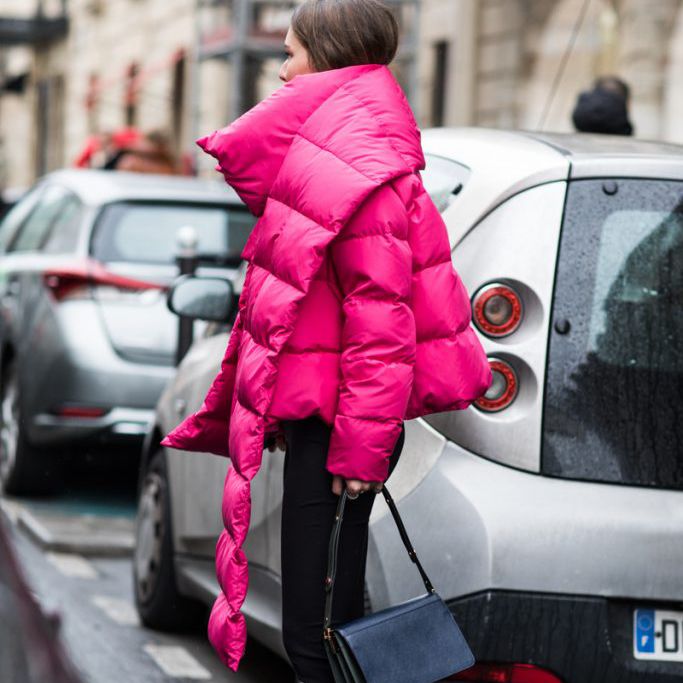Evolution of Puffer Jacket Materials
The materials used in crafting lightweight puffer jackets have undergone significant changes over the years. As we look towards 2025, we’re seeing continued innovation in the types of fabrics and fillings that make these jackets light, warm, and stylish.

Fabric Innovations
The fabrics now in use are not just about keeping you warm. They are also about breathability and weather resistance. Advances in textile technology mean that newer materials are both lighter and more durable. Fabrics with embedded nanoparticles can now repel water and stains, keeping jackets looking new for longer.
Eco-friendly Filling
Sustainability trends are influencing the evolution of puffer jackets, too. The industry is shifting away from traditional down fillings to more eco-conscious materials. These include recycled plastics and plant-based down alternatives. Not only do these materials reduce waste, but they also provide insulation comparable to traditional down.
Improved Insulation Technologies
Insulation has become more advanced, with manufacturers developing ultra-thin yet highly efficient materials. These new insulations trap body heat more effectively without adding bulk. This means that even a thin lightweight puffer jacket can now provide exceptional warmth.
Allergen-Free Materials
Lastly, allergy concerns are shaping the selection of jacket materials. Hypoallergenic fabrics that reduce the risk of triggering allergies are becoming more popular. These materials cater to a broader consumer base and enhance the comfort of the jackets.
We can expect that as we move toward 2025, these materials will not only improve in quality but will also reflect the evolving demands of environmentally conscious and health-aware consumers. Lightweight puffer jackets will continue to marry function with fashion, made possible through material innovation.
Innovative Technologies in Puffer Jacket Design
The design of lightweight puffer jackets is stepping into a new era with the adoption of cutting-edge technologies. These innovations elevate functionality, style, and the wearer’s experience. Here are a few key technological advancements that we can expect to see in lightweight puffer jackets by 2025.
Smart Fabric Integration
Developers are weaving intelligence into the very fabric of puffer jackets. The integration of smart textiles that can respond to environmental changes is a major leap. These fabrics may adjust their breathability or insulation based on the external temperature, ensuring optimal comfort.
Advanced Thermal Regulation
Managing body temperature efficiently is crucial in outerwear. Technologies enabling better thermal regulation, like phase-change materials, are in development. These materials store and release heat as needed, maintaining a stable body temperature.

Enhanced Wearability
Lightweight is the game’s name, but comfort doesn’t take a backseat. New materials and design techniques mean that future puffer jackets will offer greater freedom of movement. They will be easier to pack without comprising their thermal properties.
Wearable Technology Features
Puffer jackets are becoming more than just a layer of warmth. Expected features include built-in heating elements, health monitoring sensors, and connectivity to smartphones. This tech will add safety, convenience, and a wow-factor to the simple act of wearing a jacket.
Durability and Self-Healing Materials
Longevity is key in the design of puffer jackets. The use of self-healing materials that can repair minor punctures or tears is a prospective technology. This not only extends the jacket’s life but is also in line with sustainable fashion principles.
In conclusion, the future of lightweight puffer jackets is a blend of innovation and practicality. The industry emphasizes technologies that enhance comfort, user experience, and durability, pointing to an exciting future for outdoor apparel.
Impact of Sustainability Practices on Future Puffer Jackets
Sustainability is reshaping the puffer jacket industry. More brands are adopting eco-friendly measures. These changes are affecting everything from materials to production methods. Let’s delve into how these practices will impact future lightweight puffer jackets.
Use of Recycled Materials
The use of recycled materials is on the rise. This helps reduce waste and conserves resources. Future jackets may feature recycled plastics or repurposed fabrics. This not only helps the environment but also appeals to eco-conscious consumers.
Biodegradable and Organic Options
There’s a growing interest in materials that are biodegradable or organic. Natural fibers that break down easily after the jacket’s lifespan are gaining popularity. They reduce long-term waste and eliminate harmful environmental effects.
Ethical Down and Alternatives
The ethical sourcing of down and the use of alternatives are becoming more prevalent. This includes responsibly sourced down or plant-based synthetics. These materials provide warmth without the ethical concerns tied to animal-based fillings.
Energy-Efficient Manufacturing
Sustainable manufacturing processes are crucial. Brands are adopting lower-energy production methods. This cuts down on the carbon footprint associated with making jackets. It’s a step forward for the industry’s sustainability goals.

End-of-Life Programs
Brand-initiated recycling and take-back programs are emerging. These programs ensure jackets are repurposed or recycled at the end of their life. It encourages consumers to make responsible choices when their jackets are no longer usable.
In summary, sustainability is not just a buzzword but a driving force in the future of lightweight puffer jackets. It influences materials, production, and even the afterlife of products. Brands that prioritize these practices will likely lead the market and draw in consumers who value sustainability.
2025 Color and Pattern Trends for Puffer Jackets
As we look towards 2025, the evolution in fashion is clear. Puffer jackets are not left behind. Bold colors and innovative patterns will be the highlights in the design of lightweight puffer jackets. Here’s what we can expect in the coming years.
Vivid and Bold Colors
The future shines with a variety of vivid colors. From electric blues to fiery reds, jackets will pop with life. These colors are not just fashion statements. They also enhance visibility for safety during outdoor activities.
Earth Tones and Neutrals
Alongside bright shades, earthy tones will remain a favorite. Think greens, browns, and beiges. These colors reflect the sustainable practices embedded in jacket production. They appeal to consumers who prefer understated style.
Geometric Patterns
Expect to see more geometric prints. Triangles, rectangles, and other shapes will create dynamic looks. These patterns give a modern twist to the classic puffer jacket.
Nature-Inspired Designs
Patterns that mimic nature will also be popular. Floral prints, animal motifs, and landscape scenes will connect wearers with the environment. This ties back to the industry’s push for sustainability and eco-awareness.
Personalized and Custom Prints
With advancements in technology, custom prints will be more accessible. Consumers will be able to personalize their jackets. This will allow for unique expressions of individual style.
Reflective and Metallic Finishes
Safety meets style with reflective and metallic finishes. This feature is practical for night-time visibility and adds a futuristic touch. It complements the innovative spirit of upcoming puffer jacket designs.
In conclusion, color and pattern trends for 2025 promise a vibrant and diverse range. The emphasis will be on personality, functionality, and an inherent nod to environmental consciousness. Style-conscious individuals and outdoor enthusiasts will have plenty to choose from.
Popular Styles and Cuts for Lightweight Puffer Jackets
The 2025 landscape of lightweight puffer jackets showcases an array of styles and cuts catering to diverse preferences. With the evolving fashion dynamics, these jackets are not only about function but also about a statement of personal style.
Slim-Fit Designs
Slim-fit puffer jackets are gaining popularity for their sleek look. They provide warmth without the bulk, emphasizing a svelte silhouette. These styles are ideal for those who prioritize a fitted, stylish appearance while staying cozy.
Cropped Puffer Jackets
Cropped cuts are making a comeback, offering a hip and trendy edge. These jackets hit above the hip, perfect for pairing with high-waisted pants. It’s a style that resonates with fashion-savvy individuals seeking a youthful vibe.
Extended Length Options
For extra protection and a dramatic flair, extended length puffer jackets rise to the occasion. They can range from thigh to ankle-length, giving a unique blend of comfort and sophistication.
Unisex and Gender-Neutral Styles
The future sees an inclusive approach with unisex and gender-neutral designs. Brands are crafting jackets meant for all, removing traditional gender boundaries in fashion.
Innovative Sleeve Designs
Detachable and adjustable sleeves are anticipated to be a game-changer. They offer versatility for different climates and preferences. Jackets with innovative sleeve designs enable users to transform their look with ease.
In summary, the diversity in styles and cuts for lightweight puffer jackets in 2025 addresses the needs of style-conscious consumers who are looking for both fashion and function in their outerwear selections.
Performance Features in Next-Gen Puffer Jackets
As we approach 2025, lightweight puffer jackets are evolving with new performance features. These enhancements improve functionality and wearers’ comfort.
Enhanced Waterproofing
Expect superior waterproof capabilities in future designs. Jackets will withstand heavy rain yet remain breathable.
Wind Resistance
Advanced fabrics will offer better protection against harsh winds. Wearers will enjoy outdoor activities even in blustery conditions.
Increased Mobility
Next-gen jackets will allow greater range of movement. Designs will include stretch materials for active lifestyles.
Improved Breathability
Innovative membranes will enhance air circulation. This will prevent overheating during physical exertion.
Lighter Weight
Materials will be lighter yet retain heat effectively. Jackets will be easier to carry and wear.
Temperature Control Systems
Some jackets may boast integrated temperature controls. This allows adjustments for personal comfort in varying climates.
Multi-Functional Zippers
Zippers will serve more purposes than just closure. They might include ventilation options or sealed pockets.
In summary, performance features in 2025 puffer jackets focus on practical needs. These jackets prioritize comfort, adaptability, and protection. Shoppers will look for these qualities when choosing their outdoor gear.
The Role of Smart Wearables in Future Puffer Jackets
Integrating smart wearables into lightweight puffer jackets is setting a new standard. As we edge closer to 2025, these advancements are not only about convenience, but also about elevating the wearer’s experience with a fusion of technology and apparel. Here are some insights into how smart wearables will enhance future puffer jackets.
Built-in Connectivity
Future jackets will likely feature built-in connectivity. This means easy pairing with devices like smartphones and smartwatches. Wearers can take calls, control music, or navigate with GPS, all from their jacket sleeve.
Health Monitoring Sensors
Health sensors could be a game-changer. They may monitor heart rate, temperature, and other vitals. This is key for those leading active, health-conscious lifestyles.
Environmental Sensors
Jackets may come with sensors that read weather conditions. They can adjust the jacket’s temperature or warn about upcoming changes. This clever use of tech helps users stay prepared.
Illumination and Visibility
Safety gets a tech boost with LED lighting or e-ink for better visibility. These elements can come to life in low light, keeping wearers safe when they are outside at night.
Self-Cleaning Mechanisms
Imagine jackets that clean themselves with just a button push. Advanced materials might repel dirt or use UV light to sanitize. This kind of innovation simplifies jacket care.
Charging Capabilities
We may see jackets with the power to charge our devices. Solar panels or kinetic energy converters embedded in fabric could provide this energy. This would be perfect for those on the go.
In conclusion, smart wearables will offer cutting-edge features to lightweight puffer jackets. With technology held close to our bodies, these jackets go beyond keeping us warm. They cater to our connected, tech-savvy, and health-focused world.
Key Market Players and Designer Collaborations
The landscape of lightweight puffer jackets is witnessing an exciting interplay between key market players and designer collaborations. The industry giants are teaming up with high-end designers to create unique outerwear pieces that reflect both utility and haute couture. These partnerships cater to consumers who seek luxury with practicality in their apparel choices.
Innovating with Industry Leaders
Leading brands in the outdoor apparel sector are at the forefront of fabricating innovative lightweight puffer jackets. They are pushing boundaries by integrating high-tech materials and sustainable practices. Their commitment to advancement keeps them as favored choices among consumers who expect the best in performance and quality.
High-End Designer Influence
The touch of high-end designers introduces a new dimension of style to puffer jackets. This is where fashion meets function in a striking way. Designer collaborations bring forth exclusive patterns, avant-garde cuts, and unexpected textures that resonate with fashion-forward individuals.
Limited-Edition Releases
Unique limited-edition releases create a buzz and sense of exclusivity. These special-edition jackets quickly become collector’s items and are often highly sought after. They also showcase the innovative vision of the brands, combining creativity and technology.
Dynamic Collaborations
Dynamic collaborations between tech companies and apparel brands are setting trends. Incorporating tech features into jacket designs is a result of this partnership, which attracts a tech-savvy market segment. It’s the integration of wearability and smart technology that exemplifies the future of clothing.
Targeting Niche Markets
Custom collaborations that target niche markets are also gaining traction. These bespoke designs cater to specific consumer interests, whether for extreme sports enthusiasts or urban fashionistas. It shows a strategic direction in market segmentation and product development.
In summary, the alliance of key market players and designer collaborations is shaping a new chapter in the realm of lightweight puffer jackets. From luxurious designs to state-of-the-art functionalities, these collaborations are defining the future of outdoor lifestyle fashion. Consumers eagerly anticipate which partnerships will break the mold next, as the journey towards 2025 continues.
Consumer Preferences Shaping the Puffer Jacket Industry
Consumer preferences are pivotal in guiding the evolution of lightweight puffer jackets. As we move towards 2025, here is how consumer demand is influencing the industry.
Demand for Versatility
Shoppers want jackets that adapt to different settings. They prefer styles that suit both urban life and outdoor adventures. Versatility is key.
Focus on Sustainability
Eco-conscious consumers are making choices based on green practices. They favor jackets made of recycled materials and ethical production processes.
Personalization and Customization
Customers are drawn to jackets they can personalize. They enjoy selecting colors, patterns, and features that mirror their personality.
High Performance and Durability
People expect durable jackets that withstand diverse weather conditions. High-quality materials and construction are non-negotiable for them.
Technological Integration
Tech-savvy shoppers look for smart features in their outerwear. They desire jackets with built-in technology for health tracking and connectivity.
Price and Quality Balance
While quality is crucial, shoppers also consider price. They seek the best value for money while investing in a jacket that lasts.
In conclusion, consumer preferences are a driving force in the puffer jacket industry. Brands that listen and respond to these needs will excel in the future market.


